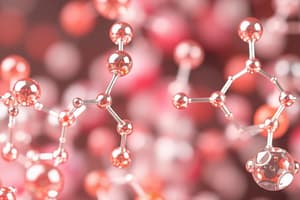Podcast
Questions and Answers
What is the geometry of the perchlorate (ClO4-) ion?
What is the geometry of the perchlorate (ClO4-) ion?
- Octahedral (correct)
- Tetrahedral
- Square planar
- Trigonal bipyramidal
What type of bonds are present between the chlorine and oxygen atoms in the perchlorate (ClO4-) ion?
What type of bonds are present between the chlorine and oxygen atoms in the perchlorate (ClO4-) ion?
- Triple bonds
- Single bonds
- Ionic bonds
- Double bonds (correct)
What is the geometry of the permanganate (MnO4-) ion?
What is the geometry of the permanganate (MnO4-) ion?
- Trigonal bipyramidal
- Octahedral
- Tetrahedral
- Square planar (correct)
How do polyatomic ions affect chemical reactions?
How do polyatomic ions affect chemical reactions?
What is an example of a polyatomic ion that can act as a catalyst in redox reactions involving halogens?
What is an example of a polyatomic ion that can act as a catalyst in redox reactions involving halogens?
How can polyatomic ions affect the reactivity of transition metal centers?
How can polyatomic ions affect the reactivity of transition metal centers?
What distinguishes polyatomic ions from monatomic ions?
What distinguishes polyatomic ions from monatomic ions?
What is the structural difference between ammonium and methylammonium polyatomic ions?
What is the structural difference between ammonium and methylammonium polyatomic ions?
How do polyatomic ions contribute to chemical reactions?
How do polyatomic ions contribute to chemical reactions?
Which term best describes the structures of polyatomic ions?
Which term best describes the structures of polyatomic ions?
What role do polyatomic ions play in the realm of chemistry?
What role do polyatomic ions play in the realm of chemistry?
How are polyatomic ions different from polymers?
How are polyatomic ions different from polymers?
Flashcards are hidden until you start studying
Study Notes
Chemical Compounds: Understanding Polyatomic Ions
In the realm of chemistry, a vast array of substances exists in which atoms of multiple elements join together to create a specific compound. These combinations can take various forms, such as covalently bound molecules or ionically linked structures. Among these compounds are polymers, which are made up of repeating units of atoms or molecules, and complex ions, referred to as polyatomic ions. Let's delve deeper into the fascinating world of polyatomic ions.
What are Polyatomic Ions?
Polyatomic ions are charged entities composed of multiple atoms held together by covalent bonds. Unlike monatomic ions, which consist of single atomic species, polyatomic ions exhibit complex and diverse structures. They often behave as individual units within chemical reactions, contributing to the intricate mechanisms and dynamics of many systems.
Structures of Polyatomic Ions
The structures of polyatomic ions vary depending on their constituents. Some common examples include:
Ammonium (NH4+)
Ammonium is a cation with a tetrahedral arrangement of atoms, featuring four hydrogen atoms bonded to a central nitrogen atom. The nitrogen atom carries a positive charge, while the hydrogen atoms carry a negative charge.
Methylammonium (CH3NH3+)
A related structure to ammonium, methylammonium possesses a similar tetrahedral geometry, with one additional hydrogen atom attached to the nitrogen atom. This modification generates a slightly different charge distribution and electron density.
Perchlorate (ClO4-)
Perchlorate is an anion featuring a symmetrical, octahedral arrangement of chlorine and oxygen atoms around the central chlorine atom. Each oxygen atom shares a double bond with the central chlorine atom, creating a highly polarized structure.
Permanganate (MnO4-)
Permanganate exhibits a square planar geometry, with manganese at the center surrounded by four oxygen atoms arranged around it. This arrangement allows for a highly polarized and stable structure, making it a powerful oxidizing agent.
These are just a few examples of polyatomic ions, and there exist many others with varying structural features and properties. Understanding their unique characteristics is essential for predicting and interpreting their behavior in chemical reactions.
How Polyatomic Ions Affect Chemical Reactions
Polyatomic ions play crucial roles in numerous chemical processes. Their presence can influence reaction rates, selectivity, and overall efficacy. By understanding the nature of these ions, chemists can tailor reactions to achieve desired outcomes and optimize conditions to maximize yield and efficiency.
For instance, in redox reactions involving halogens, polyhalides such as ClO4-, ClO3-, and ClO2- participate as catalysts, accelerating the reaction between two dissimilar metals through oxidation-reduction cycles. Additionally, polyatomic ions can serve as ligands, binding to transition metal centers and modulating their coordination environments and reactivity.
Conclusion
In summary, polyatomic ions are fascinating entities that contribute significantly to the complexity and diversity of the chemical landscape. Their intricate structures and properties enable them to play pivotal roles in countless chemical transformations, further showcasing the beauty and elegance of our understanding of the natural world.
Studying That Suits You
Use AI to generate personalized quizzes and flashcards to suit your learning preferences.




